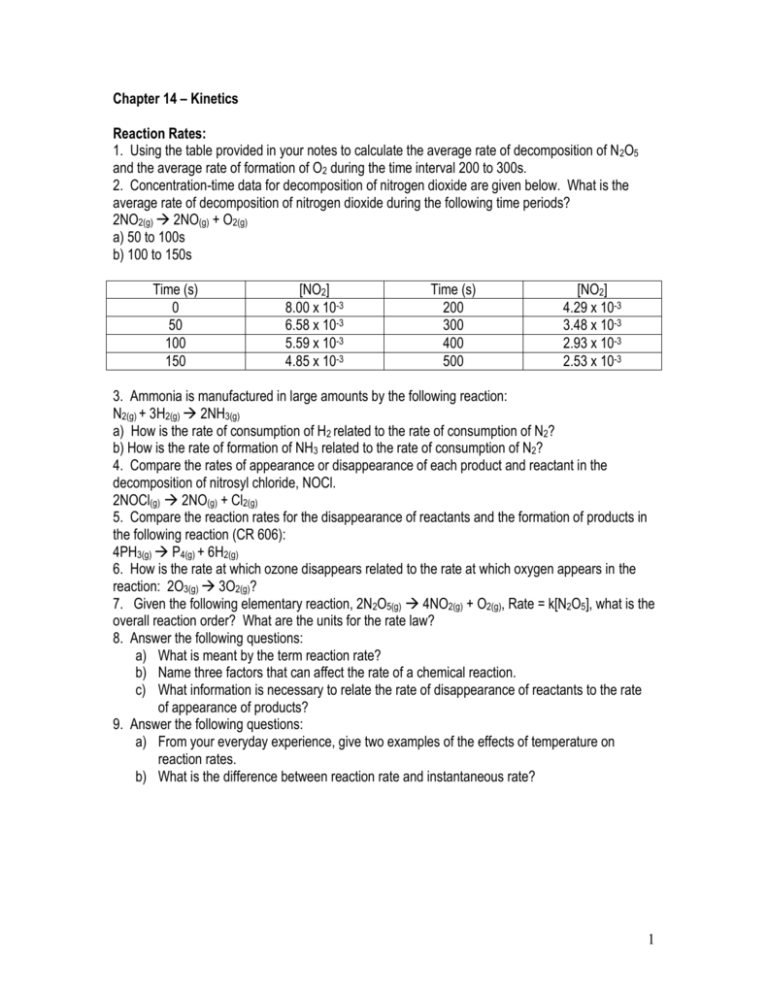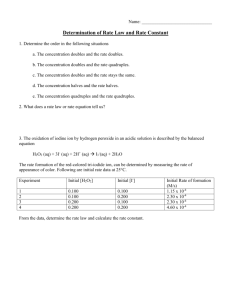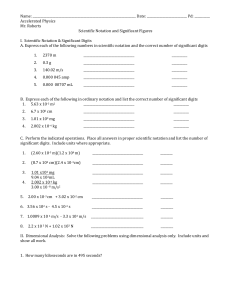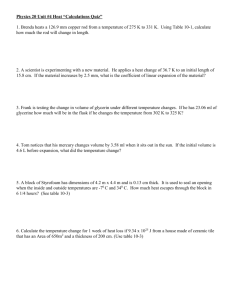Rate Laws - k-west
advertisement

Chapter 14 – Kinetics Reaction Rates: 1. Using the table provided in your notes to calculate the average rate of decomposition of N 2O5 and the average rate of formation of O2 during the time interval 200 to 300s. 2. Concentration-time data for decomposition of nitrogen dioxide are given below. What is the average rate of decomposition of nitrogen dioxide during the following time periods? 2NO2(g) 2NO(g) + O2(g) a) 50 to 100s b) 100 to 150s Time (s) 0 50 100 150 [NO2] 8.00 x 10-3 6.58 x 10-3 5.59 x 10-3 4.85 x 10-3 Time (s) 200 300 400 500 [NO2] 4.29 x 10-3 3.48 x 10-3 2.93 x 10-3 2.53 x 10-3 3. Ammonia is manufactured in large amounts by the following reaction: N2(g) + 3H2(g) 2NH3(g) a) How is the rate of consumption of H2 related to the rate of consumption of N2? b) How is the rate of formation of NH3 related to the rate of consumption of N2? 4. Compare the rates of appearance or disappearance of each product and reactant in the decomposition of nitrosyl chloride, NOCl. 2NOCl(g) 2NO(g) + Cl2(g) 5. Compare the reaction rates for the disappearance of reactants and the formation of products in the following reaction (CR 606): 4PH3(g) P4(g) + 6H2(g) 6. How is the rate at which ozone disappears related to the rate at which oxygen appears in the reaction: 2O3(g) 3O2(g)? 7. Given the following elementary reaction, 2N2O5(g) 4NO2(g) + O2(g), Rate = k[N2O5], what is the overall reaction order? What are the units for the rate law? 8. Answer the following questions: a) What is meant by the term reaction rate? b) Name three factors that can affect the rate of a chemical reaction. c) What information is necessary to relate the rate of disappearance of reactants to the rate of appearance of products? 9. Answer the following questions: a) From your everyday experience, give two examples of the effects of temperature on reaction rates. b) What is the difference between reaction rate and instantaneous rate? 1 10. The isomerization of methyl isonitrile (CH3NC) to acetonitrile (CH3CN) was studied in the gas phase at 215°C, and the following date were obtained. Calculate the average rate of reaction, in M/s, for the time interval between each measurement. Time (seconds) 0 2000 5000 8000 12000 15000 [CH3NC] (M) 0.0165 0.0110 0.00591 0.00314 0.00137 0.00074 11. The rate of disappearance of HCl was measured for the following reaction: CH3OH(aq) + HCl(aq) CH3Cl(aq) + H2O(l) The following data was collected. Calculate the average rate of reaction, in M/s for the time interval between each measurement. Time (minutes) 0.0 54.0 107.0 215.0 430.0 [HCl] (M) 1.85 1.58 1.36 1.02 0.580 12. For each of the following gas-phase reactions, write the rate expression in terms of the appearance of each product or disappearance of each reactant (CS 619): 2HBr H2 + Br2 2SO2 + O2 2SO3 2NO + 2H2 N2 + 2H2O 13. For each of the following gas-phase reactions, indicate how the rate of disappearance of each reactant is related to the rate of appearance of each product (CS 619): 2H2O H2 + O2 2N2O 2N2 + O2 N2 + 3H2 2NH3 Rate Laws: 1. Consider the following reactions and determine the order of each reaction in the various reactants and the overall reaction order: a) BrO3-(aq) + 5Br-1(aq) + 6H+(aq) 3Br2(aq) + 3H2O(l) Rate = k[BrO3-][ Br-1][H+]2 b) H2(g) + I2(g) 2HI(g) Rate = k[H2][ I2] 2 2. The oxidation of the iodide ion by hydrogen peroxide in an acidic solution is described by the balanced equation: H2O2(aq) + 3I-1(aq) + 2H+(aq) I3-1(aq) + 2H2O(l) The rate of formation of the red-colored triiodide ion, ∆[ I3-1] / ∆t, can be determined by measuring the rate of appearance of the color. Given the following initial rate data at 25°C, (a) determine the rate law for the formation of I3-1; (b) calculate the value of the rate constant; (c) calculate the rate of formation of I3-1 when the concentrations are [H2O2] = 0.300M and [I-1] = 0.400M Experiment 1 2 3 4 Initial [H2O2] 0.100 0.100 0.200 0.200 Initial [I-1] 0.100 0.200 0.100 0.200 Initial Rate (M/s) 1.15 x 10-4 2.30 x 10-4 2.30 x 10-4 4.60 x 10-4 3. Write the rate law for the following elementary reactions: a) O3(g) + O(g) 2O2(g) b) Br(g) + Br(g) + Ar(g) Br2(g) + Ar(g) c) Co(CN)5(H2O)-2(aq) Co(CN)5-2(aq) + H2O(l) d) CHCl3(g) + Cl2(g) CCl4(g) + HCl(g) e) H2(g) + I2(g) 2HI(g) 4. The gas-phase reaction of nitric oxide and bromine yields nitrosyl bromide: 2NO(g) + Br2(g) 2NOBr(g) The rate law is rate =k[NO]2[ Br2]. What is the reaction order with respect to each of the reactants, and what is the overall reaction order? 5. The rate of reaction between CO and NO2 was studied at 540K starting with various concentrations of CO and NO2, and the data in the table was collected. Determine the rate equation and the value of the rate constant (CR 612). CO(g) + NO2(g) CO2(g) + NO(g) Experiment 1 2 3 4 5 [CO] 5.10 x 10-4 5.10 x 10-4 5.10 x 10-4 1.02 x 10-3 1.53 x 10-3 [NO2] 0.350 x 10-4 0.700 x 10-4 0.175 x 10-4 0.350 x 10-4 0.350 x 10-4 Initial Rate(M/h) 3.4 x 10-8 6.8 x 10-8 1.7 x 10-8 6.8 x 10-8 10.2 x 10-8 6. Using the rate constant determined in #5, determine the initial rate of the reaction when [CO] = 3.8 x 10-4M and [NO2] = 0.6501 x 10-4M (CR 613) 7. The reaction of gaseous chloroform and chlorine is listed below: CHCl3(g) + Cl2(g) CCl4(g) + HCl(g) The rate law is rate = k[CHCl3][Cl2]1/2. What is the order of the reaction with respect to CHCl3 and Cl2? What is the overall reaction order? 3 8. The following initial rates were measured for the thermal decomposition of azomethane: CH3NNCH3(g) C2H6(g) + N2(g) Experiment 1 2 Initial [CH3NNCH3] 2.4 x 10-2 8.0 x 10-3 Rate of Decomposition (M/s) 6.0 x 10-6 2.0 x 10-6 a) What is the rate law? b) Calculate the value of the rate constant. c) What is the rate of decomposition when the concentration of azomethane is 0.020M? 9. Initial rate data at 25°C are listed for the reaction: NH4+(aq) + NO2-(aq) N2(g) + H2O(l) Experiment 1 2 3 Initial [NH4+] 0.24 0.12 0.12 Initial [NO2-] 0.10 0.10 0.15 Initial Rate (M/s) 7.2 x 10-6 3.6 x 10-6 5.4 x 10-6 a) What is the rate law? b) What is the value of the rate constant? c) What is the reaction rate when the concentrations are [NH4+] = 0.39M and [NO2-] = 0.052M? 10. The initial rate of a reaction, A + B C was measured for several different starting concentrations of A and B, and the results are as follows: Experiment Number 1 2 3 [A] (M) 0.100 0.100 0.200 [B] (M) 0.100 0.200 0.100 Initial Rate (M/s) 4.0 x 10-5 4.0 x 10-5 16.0 x 10-5 Using this data, determine the following: a) the rate law for the reaction b) the magnitude of the rate constant c) the rate of the reaction when [A] = 0.050M and [B] = 0.100M 11. The following data were measured for the reaction of nitric oxide with hydrogen: 2NO(g) + 2H2(g) N2(g) + 2H2O(g) Experiment Number 1 2 3 [NO] (M) 0.10 0.10 0.20 [H2] (M) 0.10 0.20 0.10 Initial Rate (M/s) 1.23 x 10-3 2.46 x 10-3 4.92 x 10-3 Using this data, determine the following: a) the rate law for the reaction b) the magnitude of the rate constant c) the rate of the reaction when [NO] = 0.050M and [H2] = 0.150M 4 12. A reaction, A + B C obeys the following rate law: Rate = k[B]2. a) If [A] is doubled, how will the rate change? Will the rate constant change? Explain. b) What are the reaction orders for A and B? c) What is the overall reaction order? d) What are the units of the rate constant? 13. The decomposition of N2O5 in carbon tetrachloride proceeds as follows: 2N2O5 4NO2 + O2. The rate law is first order in N2O5. At 64°C, the rate constant is 4.82 x 10-3s-1. a) Write the rate law for this reaction b) What is the rate of the reaction when [N2O5] = 0.0240M? c) What happens to the rate when the concentration of N2O5 is doubled to 0.0480? 14. Consider the following reaction: 2NO + 2H2 N2 + 2H2O a) The rate law for this reaction is first order in H2 and second order in NO. Write the rate law b) If the rate constant for this reaction at 1000K is 6.0 x 104M-2s-1. What is the reaction rate when [NO] = 0.025M and [H2] = 0.015M? c) What is the reaction rate at 1000K when the concentration of NO is increased to 0.10M, while the concentration of H2 is 0.010M? 15. Consider the following reaction: CH3Br + OH-1 CH3OH + Br-1 The rate law for this reaction is first order in CH3Br and first order in OH-1. When [CH3Br] is 5.0 x 10-3M and [OH-1] is 0.050M, the reaction rate at 298K is 0.0432M/s. a) What is the value of the rate constant? b) What are the units of the rate constant? c) What would happen if the concentration of OH-1 were tripled? 16. The iodide ion reacts with the hypochlorite ion (the active ingredient in chlorine bleaches) in the following way (CS 619): OCl-1 + I-1 OI-1 + Cl-1 The rapid reaction gives the following rate data: [OCl-1] (M) 1.5 x 10-3 3.0 x 10-3 1.5 x 10-3 [I-1] (M) 1.5 x 10-3 1.5 x 10-3 3.0 x 10-3 Rate, M/s 1.36 x 10-4 2.72 x 10-4 2.72 x 10-4 a) Write the rate law for this reaction b) Calculate the rate constant c) Calculate the rate when [OCl-1] = 2.0 x 10-3M and [I-1] = 5.0 x 10-4M 5 17. The following data were measured for the reaction BF3 + NH3 F3BNH3: Experiment 1 2 3 4 5 [BF3] (M) 0.250 0.250 0.200 0.350 0.175 [NH3] (M) 0.250 0.125 0.100 0.100 0.100 Initial Rate (M/s) 0.2130 0.1065 0.0682 0.1193 0.0596 a) What is the rate law for this reaction? b) What is the overall order of the reaction? c) What is the value of the rate constant for reaction? d) What is the rate when [BF3] = 0.100M and [NH3] = 0.500M? 18. Consider the reaction of peroxydisulfate ion with iodide ion in an aqueous solution (CS 620): S2O8-2 + 3I-1 2SO4-2 + I3-1 At a particular temperature the rate of disappearance of S2O8-2 varies with reactant concentration in the following manner: Experiment 1 2 3 4 [S2O8] (M) 0.018 0.027 0.036 0.050 [I-1] (M) 0.036 0.036 0.054 0.072 Initial Rate (M/s) 2.6 x 10-6 3.9 x 10-6 7.8 x 10-6 1.4 x 10-6 a) Determine the rate law for the reaction b) What is the rate of disappearance of I-1 when [S2O8] = 0.015M and [I-1] = 0.040M? Mechanisms: 1. A suggested mechanism for the reaction of nitrogen dioxide and molecular fluorine is: NO2(g) + F2(g) NO2F(g) + F(g) F(g) + NO2(g) NO2F(g) (a) Give the chemical equation for the overall reaction, and identify any reaction intermediates (b) Specify the molecularity of each of the elementary reactions 2. The following substitution reaction has a first-order rate law: Co(CN)5(H2O)-2(aq) + I-1(aq) Co(CN)5I-3(aq) + H2O(l) Rate = k[Co(CN)5(H2O)-2] Suggest a possible mechanism, and show that your mechanism is in accord with the observed rate law. 3. Tell what is meant by each of the following terms: a) reaction mechanism b) elementary reaction c) molecularity d) reaction intermediate 6 4. What distinguishes the rate-determining step from the other steps in a reaction mechanism? How does the rate-determining step affect the observed rate law? 5. Consider the following mechanism for the reaction of hydrogen and iodine monochloride: Step 1: H2(g) + ICl(g) HI(g) + HCl(g) Step 2: HI(g) + ICl(g) I2(g) + HCl(g) a) Write the equation for the overall reaction b) Identify any reaction intermediates c) What is the molecularity of each elementary step? 6. The following mechanism has been proposed for the reaction of nitric oxide and chlorine: Step 1: NO(g) + Cl2(g) NOCl2(g) Step 2: NOCl2(g) + NO(g) 2NOCl(g) a) What is the overall reaction? b) Identify any reaction intermediates c) Identify the molecularity of each elementary step 7. The hypochlorite ion undergoes self oxidation-reduction to give chlorate, ClO3-1, and chloride ions: It is thought that the reaction occurs in two steps: Step 1: ClO-1(aq) + ClO-1(aq) ClO2-1(aq) + Cl-1(aq) Step 2: ClO2-1(aq) + ClO-1(aq) ClO3-1(aq) + Cl-1(aq) a) What is the overall reaction? b) Identify any reaction intermediates c) What is the molecularity for each elementary reaction? d) Show that the sum of these reactions gives the equation for the net reaction 8. The proposed mechanism for the reaction of nitric oxide and water is listed below: Reaction: 2NO(g) + 2H2(g) N2(g) + H2O(g) 2NO(g) N2O2(g) N2O2(g) + H2(g) N2O(g) + H2O(g) N2O(g) + H2(g) N2(g) + H2O(g) a) What is the molecularity of each of the three steps? b) What is the rate equation for the third step? c) Show that the sum of these elementary steps gives the net reaction? 9. It has been proposed that the conversion of ozone into O2 proceeds by a two-step mechanism: O3(g) O2(g) + O(g) O3(g) + O(g) 2O2(g) a) Describe the molecularity of each elementary reaction in this mechanism b) Write the equation for the overall reaction c) Identify any intermediates 7 8







